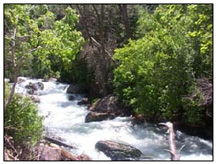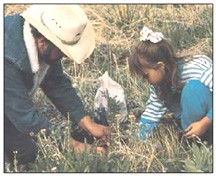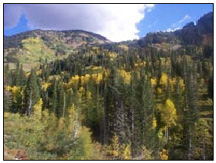Growing Trees
Mother Nature helped in restoring the Wasatch Forest.
January 18, 2000
|
Likewise, early pictures of the Salt Lake valley rendered a scene absent of trees. It is common knowledge that the early pioneers planted trees in order to provide shade and beauty to what most described as a barren and inhospitable land. An early description written by pioneer Orson F. Whitney read, “Aside from its scenic splendor...there was little to invite and much to repel in the prospect to their [the pioneer’s] view. On all sides a seemingly interminable waste of sagebrush bespangled with sunflowers, the paradise of the lizard, the cricket and the rattlesnake.” From most early accounts, trees were not indigenous to the Salt Lake valley other than those trees growing along the various canyon streams as they flowed through the valley to the Jordan River. Pictures taken at the turn of the twentieth century during the construction of the Big Cottonwood Conduit showed the farmland west of Big Cottonwood Canyon with trees lining only the various farm boundaries. Today the area comprising of the Cottonwood and Holladay communities is covered with a thick lush blanket of greenery.
In an article published on August 10, 1915 in the Municipal Record, entitled, “Trees Control Water Supply Western Valleys,” by J.H. Paul, Professor of Nature Study at the University of Utah it appears that City officials took action to improve the Wasatch Canyon watershed by planting trees.
The following is transcribed verbatim from the article:
“Extensive planting of trees which is necessary to insure a permanent supply of water throughout the summer in the valleys of the West, means reforestation and new forestation on a large scale. What is needed will be trees not merely by the hundreds or thousands, but by millions and hundreds of millions. Such numbers of trees will be called for in the near future. Real reforestation is work that will tax our resources and occupy the statesmanship of leaders to come. But later, when the forest crop begins to mature and the water supply of the valleys is rendered more permanent, more abundant, and more uniformly distributed throughout the year, the results of the policy here advocated will be so beneficial, so apparent, so widespread in their effects, that none will regret the labor and expense necessary for the ends accomplished.
Trees in Valleys and Towns
In our valley forestation is practicable and on a comparatively large scale. Every area moist enough to give trees a start will suffice for the practical creation of a grove. Along every water course certain trees should be planted, if only cottonwoods and poplars. This may be done by order of city and county commissioners. No city officials in the future should permit any of the sidewalks within the city, except those on the streets of heavy business traffic, to be devoid of shade trees.
Many kinds of trees are suitable for the city shade, especially maple, ash, sycamores, linden, black walnut, and above all, the English walnut, that has been acclimated to our region. The Hardwoods, of Salt Lake, have succeeded in developing strains of these splendid trees that do not winter-kill with the frosts of Salt Lake valley. The trees are beautiful are beautiful in foliage, massive and oaklike in appearance, and bear in seven to ten years from the time of planting, an annual crop of perhaps a hundred pounds of nuts.
Among evergreens, the world has not produced anything else so fine as the blue or Colorado spruce, and our own Rocky Mountain and Utah junipers. Then there are the yellow pine and the Douglas firs for the larger trees. There may all be grown with success by those who desire evergreens -- and who does not.
To the end that the valleys of our region may be beautiful -- with groves of timer, including evergreens and hardwoods -- and that the water supply of these valleys may be conserved and guaranteed forever, the following observations are respectfully submitted to the judgment of an intelligent public opinion.
Effects of Mountain Groves
The need of reforestation and of more careful limitation of grazing was strikingly brought out by the case of the stream which flows down Nine Mile Creek into Mayfield, San Pete County Utah. A few summers ago I had occasion to visit this canyon, and a storm was in progress as we went up. For many miles the stream was filled with soil washed down from the mountain sides.
|
Where Steams Are Clear
At a certain distance up the stream a remarkable change was noted. Above a certain point the stream was no longer filled with mud and gravel, but was relative unladen with debris and other mud, although it had been raining there just as it had rained lower down the canyon. The difference was so noticeable that I made inquiry of the people there as to the cause.
Why this change in the amount of soil and mud in the water above a certain point in the canyon? I was informed that above this point the forest reserve began, and unlimited grazing was not permitted there. As a consequence the grasses and underbrush which had formerly been largely grazed off had renewed their growth, in a few years and the further loss of soil from these mountain sides was inconsiderable. Wherever the forest reserve extended, the mountains were fairly well covered with vegetation, including shrubs and some trees. Where the reservation was not in operation, the trees were mostly gone and the scrubs had disappeared. From the forest areas the streams came down clear and not greatly swollen during the raging storms. Where forest supervision did not exist, the streams would bill to overflowing with the mud, stones, and debris of the hillside, which were rapidly being washing bare.
The Carpet of Shrubs
It is submitted that what goes on in the Mayfield stream is duplicated in most of the valleys of the Rocky Mountain region. Other places may not be so bad as this locally. In Mayfield the people were so confident that the stream’s banks were so high that no conceivable flood could reach their top. The summer after I was there this supposition was shown to be an illusion, for the flood came above the banks and destroyed a great deal of property in that region. In fact, there is no such thing as security from mountain floods unless the mountains are well wooded or covered with the smaller vegetation that can hold back the downpour of rain that is likely at any time to fall there. It is the wooded areas and the vegetative cover that in all cases hold back the flood; and it is these covers of the mountains that regulate the flood of the streams. Without such vegetative covers the water of the mountains will all come down in spring and early summer, leaving the later summer and fall without mountain water.
Since this condition is rapidly becoming worse in a great many places, and is only arrested in places where forest regulations prevails, it is the belief of the writer that active steps should be taken by the people of all the western valleys to see that the forest cover is not removed from the regions that supply summer and fall water. Wherever it is necessary or desirable to remove the timber, this should be done only under intelligent supervision, and provision should be made for retimbering the areas from which the timber is taken.
Water for All Time
Many of the upper divides now bare will support a growth of some kind of timer if trees are planted on them. It would be the course of wisdom to proceed with this planting as rapidly as possible. If this replanting of trees and the conservation of the chief groves now existing are not soon carried out, it is the prediction of certain engineers who have made a study of the situation, that the water supply of many of the valleys of the Rocky Mountains will be in whole or in part cut off during the months when it is most needed.
The beginning of the diminishing return of water has already commenced in numerous localities. Fifty years will see it culminate at the present pace of destruction, from which time the population and power of the Rocky Mountain region will go rapidly downward. My own hope is, that there may be some error in such predictions, but the calamity of a diminishing water supply is certainly impending.”
Inasmuch as this was published in Salt Lake City’s Municipal Record, City officials must have believed Professor Paul's concern and recommendations. Nearly three years later it was reported in the May 15, 1918 Municipal Record that reforestation had begun. “Reforestation of city watersheds, with the twofold purpose in view of increasing and preserving the water supply, and enhancing the natural beauty of the canyons, has occupied the earnest attention of the water department,” the article stated, and continued by stating that 2,200 lodge pole evergreens were planted in City Creek with the aid of National Forest Service. The Municipal Record further noted that the federal government urged Salt Lake City to wait a year and if the plantings were successful, then “many
|
There is further evidence that the National Forest Service planted trees on both city and forest lands. On October 12, 1912 Salt Lake City and the United States Department of Agriculture entered into an agreement for the “Cooperative Administration of National Forest Lands and City Lands” within Salt Lake City’s watershed. The agreement provided that Salt Lake City would not lease, sell, or otherwise dispose of any of its lands or timber and further prohibited livestock grazing on city and forest lands. The District Forester was authorized to administer and control all watershed lands to prevent trespasses and fires; and to improve the forest areas within the watershed and to protect the water supply for Salt Lake City. Clause 6 of the agreement dealt with the planting of trees on city and forestlands. The Forest agreed to plant 100 acres of trees per annum on city land upon the City’s request for the first five years of the agreement and 200 acres per annum each of the following years. The City would reimburse the Forest for their actual expense in planting the trees. The Forest agreed to plant an equal amount of trees on forestlands without cost to the City. A maximum five-acre demonstration tree-planting project was to be initiated during 1913 in a selected area in Parleys Canyon.
It’s not certain if the tree-planting program continued, and if it was, how many trees were planted in the Wasatch Canyons. But as advocated by Professor Paul, trees have made a significant impact on the quality of our lives and our drinking water.
Today the Wasatch Canyons and Salt Lake valley are adorned with trees of numerous species.
Questions regarding this article can be directed to: leroy.hooton@ci.slc.ut.us


